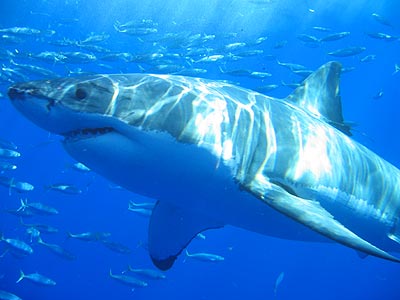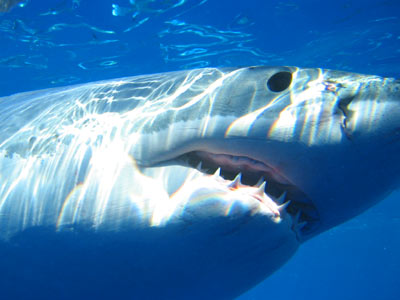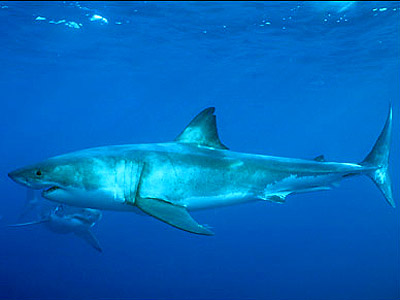Isla Guadalupe:
This season Absolute Adventures-Shark Diver introduced 144 excited divers to the wild world of white sharks during our eight-week shark season. What we encountered there on our first expedition was nothing short of spectacular and began with an extraordinary introduction to one very wild great white that we quickly named “Shredder.”
Shredder
Arrival to Guadalupe is always exciting for our divers and crew. Divers wake up after a 20-hour crossing from San Diego, California and walk to the bow of our vessel with coffee in hand investigating and filming the island’s ancient tangle of volcanic formations, cinder cones and Devil’s Post Piles while we set up for our three-day stay. Many of our divers say they half expect to see some kind of flying dinosaur swoop down from the high 3000-foot craggy peaks after our arrival. Guadalupe is that kind of wild “off the beaten track” kind of place, 210 miles from nowhere located in deep blue waters of the Pacific. The perfect place for world-class tuna fishing and as it turns out unparalleled white shark diving.
Our first encounter with a 14-foot male white shark complete with “shredded” dorsal fin and several deep bite marks on his head happened at 7.00am. He came in fast from the left, our first sight was of his mangled dorsal fin slicing through the surface toward our hang baits (tuna). He hit the first one with an unexpected fury, then turned and zeroed in on the second hang bait missing it and disappearing into the blue distance. Closer inspection of this deeply scarred shark revealed his entire left eye was milky; it had been damaged in the encounter with a larger more aggressive shark in years past. These impressive wounds should have killed this animal. But apex predators, such as this one, can sustain a lot of physical damage as we discovered later in the season with Chompers, Top Notch and Split Fin, not to mention Maximus, who was missing clearly one-third of his tail to a very recent bite.

Another smaller 10-foot female we named Cuddles soon joined us along with two unidentified males. Her disposition was perfect for shark diving. Slow moving, cautious, and inquisitive at the same time. She had an unusually large and distended belly, looking like she had fed very well recently. Shredder on the other hand was quirky, fast moving and very aggressive, attacking hang baits (tuna) with abandon and flashing past our 20-foot shark cages at top speed thrilling our divers. Even in 100-foot visibility a white shark can sneak up on divers they will not even know is there until it’s right on top of them. Fortunately we have 100 square feet of cages between our divers and these animals. Even so, having a shark like Shredder with his scarred face and milky eye run his pectoral fins along the cage bars like a school kid on the neighbors fence is a bit unnerving even to the most dedicated shark diver.
Over the three days we spent at Guadalupe, our divers filmed and dove with over 14 different Great Whites. But it was Shredder who stole the show. His arrivals on site were always quick, coming in fast from either the left or right and staying just long enough to destroy one or two hang baits in a powerful display of predation. This was also one of the few sharks we encountered that seemed to be “aware” of the divers in our cages, spending time to investigate them with his good eye on several extremely close passes.
S
Shredder Takes a Bitehredder Takes a Bite
I was up in the wheelhouse with Scotty, our boats captain, during the last dive at the island. This had been an amazing expedition thus far and our shark cages were loaded for the last time with die-hard shark divers. At the time three new sharks in the 10-13 foot class were entertaining them. Kevin and Matt, two divers not in cage rotation, were fishing for “last chance” tuna on the bow of our 86-foot dive boat the Ocean Odyssey when our crew in the wheelhouse heard a large splash. Seconds later, a startled voice called up to us, “Umm…Hey! A shark just blasted up and severed the anchor cable from our boat!” That was Matt. One look into his face and I knew he was speaking the truth.
Scotty was not unsure, saying, “That’s a rated 20,000 pound poly-pro anchor cable. There’s no way a shark just bit through it.” One of the ship’s crew was summoned forward to have a look and sure enough came up with the last five feet of cable ending in one very messy shredded fray. A 14-foot Great White had just leapt up almost ten feet clear out of the water and bit through our anchor cable, about the size of a man’s wrist and designed to hold an 86-foot dive boat in place in even the roughest weather conditions!

We were now adrift with shark cages fully deployed, sharks in the water and Shredder who had just acquired a new taste for anchor cables. In the history of shark diving I doubt this has ever happened to another dive boat. The crew raced forward and aft, we had our shark divers calmly exit the cages 30 minutes earlier, pulling them from the water in record time. In exactly 20 minutes, we had the ship squared away and ready to get under power. Once we had settled down, our divers were thrilled. After all you cannot call it an “Absolute Adventure” until a shark chews through your anchor cable!
The Theory e Theory
It is rare for Great Whites to randomly attack objects that are unusual or strange to them, although there’s data from the Farallon Islands in San Francisco showing attacks on objects floating out there. The difference is the Farallons are well known for extremely poor visibility. In fact, twenty feet of visibility is considered a great day out there. White sharks are primarily visual predators, so it is not surprising to see data coming from the Farallons of sharks in poor visibility attacking objects that resemble a prey.

In this case, we believe that Shredder (due to the damage in his left eye) just has to “try harder” to survive. It is a form of apex predator adaptability. With a handicap like a missing eye, this animal has to attack far more objects in his quest for food sources just to stay alive. Our anchor cable being white in color and as round as a man’s wrist might have seemed like an intestine from a dead whale or some other food source. Either way, his attack mode was both spectacular and devastating. Unfortunately, none of our crew got to witness what must have been simply amazing to witness.
Great White sharks at Isla Guadalupe never cease to amaze and thrill our divers and our crew. This is truly the last great outpost for this apex predator and we are fortunate to be able to explore their world for three short months each year surrounded by and island and shark diving conditions that are the envy of the world. We’ll continue expeditions again next season 2004 with ten planned weeklong expeditions and a brand new “anchor chain.” Every day we learn more about these magnificent animals. Fortunately for us, there’s only one “Shredder” at Isla Guadalupe.
 |

